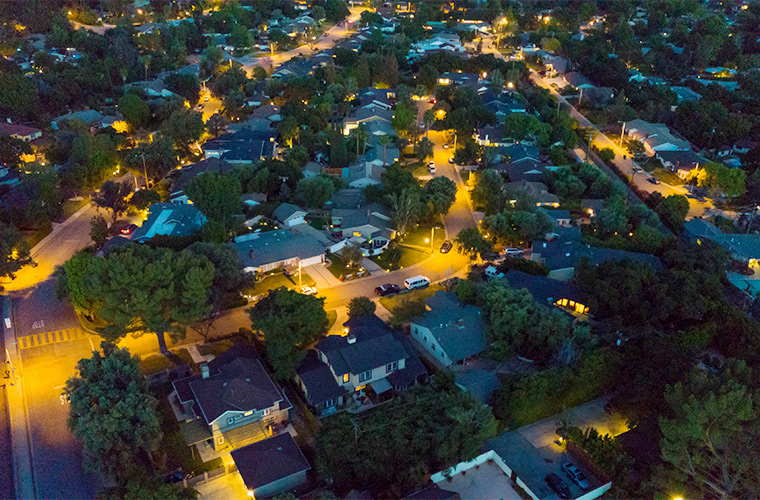How distributors can engage manufacturers and communities to help municipalities avoid backlash on their community lighting projects.
If the goal of “community-friendly lighting” is to create environments with improved visibility while limiting light trespass and glare, and at the same time preserving the ambiance of a given community, one would think it a good idea to talk to the folks who live there before swapping out all the lights. Such community outreach is unfortunately rare, according to Bob Parks, Executive Director of the Smart Outdoor Lighting Alliance (SOLA). Parks presented a seminar on Community Friendly Lighting last week at the LEDucation Conference in New York.
“Unfortunately cities often don’t feel the need to engage the public, because they’ve never done it before,” says Parks. “For decades, that was the purview of the transportation departments and they were the experts. They did lighting installations based on what they understood to be the best way to do it. But I want to stress this: too often they have little or no formal training in lighting design.”
What municipalities do, more often than not, says Parks, is rely on lighting manufacturers to “design” the lighting. They give the manufacturer the specifics of the project and the manufacturer runs it through a computer program. This gives the municipality a lighting plan which attempts to meet lighting standards like the IES RP-8 for luminance and uniformity, and satisfies the city government’s need to provide public safety. Done and done. Right? Maybe not.
A lot of cities are pretty tone-deaf about this. While residents are lining up to tell the mayor that the new lighting installed is too bright, glaring and is flooding into their bedroom windows, the city lighting staff is telling him “We’ve met all the requirements, we met the standards, everything is good.”
The level of complaints and public scrutiny has risen dramatically since the widespread adoption of LEDs. Where is the disconnect?
“Broad spectrum white light has made it possible to “weaponize” lighting so that, instead of just being annoying, it infringes on the public’s basic right to enjoy their neighborhood,” Parks explains. “The fundamental difference with broad-spectrum white light is that problems like glare and light trespass are exacerbated. So you experience it much more intensely than what you had with the older amber-yellow light of the high-pressure sodium.”
Parks maintains that with broad-spectrum light, outdoor environments can do more with less – even as much as 50 percent less light – and still achieve the same visibility that they got in the past using high-pressure sodium. What often happens though, is municipalities will still over light. This happens for a multitude of reasons: typically the pole spacing is dictated by where utilities need them, not by lighting concerns, and that means that they may be too far apart. Cities are extremely reticent to add additional poles because of the high cost. This results in fixtures being chosen that project light at very high angles in an attempt to meet uniformity standards. The result can be a lot of glare and light trespass. In addition, lighting standards haven’t been revised to reflect the increased visibility of LED technology. So unless municipalities adhere to minimum illumination level recommendations in standards like the RP-8, the result will be too bright, especially in residential areas. Compounding the problem, cities will routinely err on the side of over-lighting to help make citizens feel safer, even when the data shows that it doesn’t actually reduce crime.
But, what about the complaints jamming the switchboard at city hall from citizens who say their cozy town now feels like an outdoor arena? Here are some tips to help save time, money, and the potential for backlash:
- Lighting distributors should play both ends towards the middle. Develop and maintain constant contact with key manufacturers who will tap into your company for lighting design expertise. Similarly, lighting distributors should cultivate and grow relationships with contractors, architects, city planners, transportation officials and municipal officials to be top of mind when a municipality opens up an RFP.
- Before a city launches a lighting upgrade, they should conduct outreach efforts like town hall meetings. Explain the goals of the lighting upgrade and how the public can be engaged during the process in order to provide feedback.
- Pilot test it in the field. Show the public a wide range of options by pilot testing different fixtures with reduced glare, uplight, color temperature, and illumination levels. Solicit feedback from residents, police and city officials with a survey that uses neutral questions.
- Lighting color is a community preference that should be assessed. Remember that higher CCT also increases the perception of glare and light trespass.
- Urge cities to budget for controls in their upgrade from the start. It is less expensive than adding them later. The extra funds spent early on can be made up for in savings down the road.
- Promote the concept of dimming to meet IES RP-8 recommendations after peak periods in order to preserve the ambiance and character of neighborhoods, reduce sky glow and to save energy and costs.
You can find more information on community friendly lighting on the Smart Outdoor Lighting Alliance website here.
Tagged with community lighting, lightED
